Researchers have predicted a new carbon network, similar to graphene, but with a more complex microstructure, which may lead to better electric vehicle batteries. Graphene is arguably the most famous peculiar form of carbon. It has been tapped as a potential new game rule for lithium-ion battery technology, but new manufacturing methods can eventually produce more power-intensive batteries.
Graphene can be seen as a network of carbon atoms, where each carbon atom is connected to three adjacent carbon atoms to produce tiny hexagons. However, the researchers speculate that in addition to this direct honeycomb structure, other structures can also be generated.
This is the new material developed by a team from the University of Marburg in Germany and Aalto University in Finland. They coaxed carbon atoms into new directions. The so-called biphenyl network is composed of hexagons, squares and octagons, which is a more complex grid than graphene. The researchers say that, therefore, it has significantly different, and in some respects, more desirable electronic properties.
For example, although graphene is valued for its ability as a semiconductor, the new carbon network behaves more like a metal. In fact, when only 21 atoms wide, the stripes of the biphenyl network can be used as conductive threads for electronic devices. They pointed out that at this scale, graphene still behaves like a semiconductor.
The main author said: “This new type of carbon network can also be used as an excellent anode material for lithium-ion batteries. Compared with current graphene-based materials, it has a greater lithium storage capacity.”
The anode of a lithium-ion battery is usually composed of graphite spread on copper foil. It has high electrical conductivity, which is not only essential for reversibly placing lithium ions between its layers, but also because it can continue to do so for potentially thousands of cycles. This makes it a highly efficient battery, but also a battery that can last for a long time without degradation.
However, more efficient and smaller alternatives based on this new carbon network can make battery energy storage more intensive. This may make electric vehicles and other devices that use lithium-ion batteries smaller and lighter.
However, like graphene, figuring out how to manufacture this new version on a large scale is the next challenge. The current method of assembly relies on a super smooth gold surface on which carbon-containing molecules initially form connected hexagonal chains. Subsequent reactions connect these chains to form square and octagonal shapes, making the final result different from graphene.
The researchers explained: “The new idea is to use adjusted molecular precursors to produce biphenyl instead of graphene. The goal now is to produce larger sheets of material so that its properties can be better understood.”
Post time: Jan-06-2022


